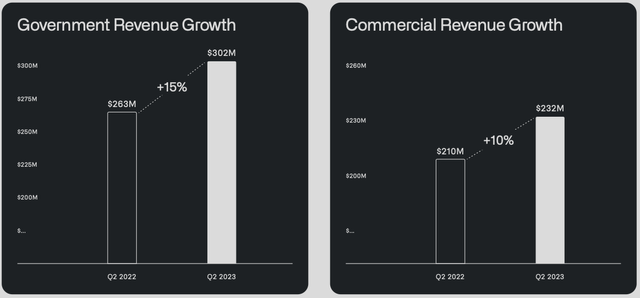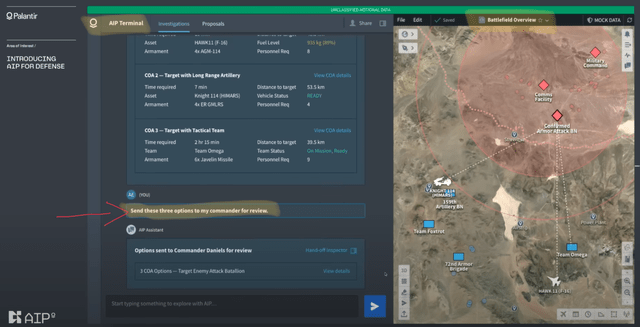Kevin Dietsch
Investment Thesis
Despite Palantir Technologies' (NYSE:PLTR) revenue growth of 13% year-over-year in Q2 and management's forecast of 16% in Q3, the market expects more for a company seen as a leader in the artificial intelligence (AI) space, especially compared to its stronger growth rates in prior years. The deceleration in growth can be partly attributed to the high cost of Palantir's software, coupled with a relatively small customer base of just 421 clients.
I am also concerned about why Palantir did not disclose the breakdown in commercial and government segments for its customer count in Q2, as they used to do until now. Nevertheless, following my last coverage on Palantir, I booked profits on the way up, but I remain long for the stock over the long term, as the initial investment thesis has not materially changed, apart from the growth rate, which counterbalances the profitability path.
Data by YChartsQ2 Update: Record Revenues, Profitability, and Growth Milestones
Palantir had a strong performance in Q2 2023, marking significant revenue growth, profitability, and operational efficiency achievements. The company's GAAP profitability for the third consecutive quarter, with $28 million net income and $10 million operating income, highlights its growing financial stability.
Revenues for the quarter totaled $533 million, a 13% increase YoY and a 2% sequential rise, surpassing the high end of guidance. Excluding the impact of strategic commercial contracts, total revenue grew 16% YoY and 5% sequentially. Notably, Palantir achieved a major milestone by crossing $2 billion in revenue on a trailing 12-month basis for the first time.
Also, Palantir's bookings indicate progress, with Total Contract Value booked reaching $642 million, a 62% sequential increase. Billings also grew significantly, rising by 52% YoY to $603 million. The company's remaining deal value stood at $3.4 billion, supported by remaining performance obligations of $968 million.
However, efficient cost management is evident in Palantir's performance, as indicated by an 81% adjusted gross margin and a 25% adjusted operating margin, outperforming prior guidance. The company's focus on cost-effective strategies, leveraging G&A and cloud efficiencies, contributed to this margin expansion.
Looking forward, Palantir is confident in its sustained GAAP profitability and has plans to invest in its new product, AIP, and expanding globally. With its growing financial stability, Palantir's Board of Directors has authorized a stock repurchase program of up to $1 billion, reflecting their confidence in the company's trajectory and stock value.
Investor Presentation (Palantir)
Government-First Strategy
Originally, Palantir's software was exclusive to government agencies. However, the company has since expanded its reach to include commercial clients. Despite this diversification, government revenue is pivotal, contributing to 57% of the company's Q2 revenue. Even more impressive is that the government segment is growing faster than its commercial counterparts.
Specifically, the government segment also performed well, with revenue growing 15% YoY to $302 million. US Government revenue increased by 10% YoY, while international government revenue experienced remarkable growth, surging 31% YoY and 29% sequentially, primarily due to work with the UK Government.
Also, Palantir's strategic expansion can be observed in regions like Japan, Korea, Canada, and the Middle East, aided by partnerships with companies like Fujitsu. The UK Government business stands out, driven by collaborations with organizations like the NHS and the UK Ministry of Defense.
While US Government revenue results were underwhelming in Q2, multi-year contracts with entities like the US Special Operations Command and converting Army Research Lab funding signifies the company's enduring strength and potential for significant deals.

Investor Presentation (Palantir)
On the contrary, Palantir's commercial segment reported revenue growth of 10% YoY, reaching $232 million, despite a 2% sequential decline attributed to strategic contract fluctuations. Excluding these contracts, commercial revenue increased by an impressive 19% YoY and 5% sequentially. The US commercial sector saw robust growth, with a 20% YoY increase and a 7% sequential rise, demonstrating the company's success in winning and expanding customer accounts.
Furthermore, the US commercial business delivers outsized results based on growing customer counts and network effects. Locked-in deals span approximately 30 industries, including healthcare and transportation, with substantial YoY growth. Foundry's impact is seen in healthcare facilities based on efficiency gains in nurse scheduling and patient placement at institutions like HCA, Tampa General, and the Cleveland Clinic.
One thing that caught my attention from the latest earnings call is that Palantir did not disclose the customer count for its commercial and government segments, as they used to do in prior quarters, which is concerning as the market seeks validation for the commercial segment to outperform the government. In contrast, they only disclosed the total customer count, which grew by 8% QoQ to 421, in line with the prior quarter's average growth.
Nevertheless, the importance of commercial clients is expected to rise over the long term, given the larger market potential. Yet, regardless of how far we peer into the future, government contracts are anticipated to remain a substantial component of Palantir's investment strategy.
Revolutionizing Industries with AIP
Palantir demonstrated strong operational performance and strategic focus in Q2 2023 based on delivering impactful results while capitalizing on AI opportunities. The recently launched Artificial Intelligence Platform (AIP) product offering has garnered significant interest, with over 150 organizations participating in AIPCon.
AI has been a cornerstone of Palantir's products from the very beginning. This aspect of AI gained immense popularity with the ascent of ChatGPT in late 2022. AIP aims to facilitate the seamless integration of AI and LLMs into Palantir's core product suite. However, the latest surge in AI interest revolves around Large Language Models (LLMs) designed to generate content that mimics human speech.
Palantir is strategically positioned to leverage its AI platform, which integrates LLMs into enterprises to enhance data integration, AI application development, and human-agent collaborations. The AIP platform enables organizations to deploy LLMs within their private networks, ensuring controlled, governed, and trusted AI operations.
Technically, AIP integrates LLMs with algorithmic and software tools to enhance their capabilities. The platform includes features like AIP Builder for natural language data pipeline creation, AIP Terminal for dynamic ontology exploration, AIP Logic for building LLM-backed functions, and AIP Automate for creating agents and automation. AIP Assist, another offering, provides context-aware help and support to users, enhancing their productivity.
Imagine AIP as a super-smart computer system that uses advanced AI to help military teams make important decisions. It's like having a clever assistant on your side during military operations. For instance:
- Identifying Enemy Forces: AIP can quickly spot and identify enemy forces gathering near a border. It's like having a pair of extra eyes that can see things even from far away.
- Using Drones: AIP helps operators use reconnaissance drones effectively. Think of it as guiding flying cameras to get important information about what's happening on the ground.
- Tactical Planning: It also helps plan tactics. When playing a game, you strategize moves, and AIP suggests smart moves for dealing with the situation.
- Jamming Enemy Communication: AIP can even interfere with the enemy's communication, making it harder for them to coordinate. It's like disrupting their phone calls and messages.
- Evaluating Strength: It tells you how strong the enemy is and what they can do. It's like having a military expert by your side advising you.

vice.com
To make sure this AI is used responsibly and follows the rules:
- Classified System: AIP runs on a unique, secure computer system that separates classified and non-classified information. It's like having locked cabinets for secret documents.
- Control: Users can set limits on what AIP can do, like setting rules for a robot. This way, people are still in charge, and everything AIP does can be checked. It's like a supervisor watching over AIP.
- Guardrails: Think of guardrails as safety barriers on a road. They make sure AIP stays on track. These guardrails also watch what AIP is doing and make sure it behaves correctly. It's like having someone make sure AIP follows the rules.
Therefore, Palantir's AIP is a powerful tool that helps military teams make better decisions and stay safe. It's designed to be safe and responsible, following strict guidelines and rules to ensure everything goes smoothly during military operations.
Investors Takeaway
In conclusion, Palantir's Q2 2023 performance showcases a company at the pinnacle of its strength, with record-breaking revenues, profits, and growth landmarks. Consecutive quarters of GAAP profitability, impressive revenue figures, and proactive cost management strategies underscore their demonstrated financial stability.
Their continued dominance in the government sector and growing influence in the commercial realm speak to their strategic diversification, even as they recognize the continued significance of government contracts in their overall strategy. Additionally, the introduction of AIP, leveraging the booming interest in AI and LLMs, further accentuates Palantir's forward-thinking approach, catering to commercial and defense applications.
Finally, the company's trajectory indicates a prosperous past, present, and promising future as it innovates and adapts to the ever-evolving tech landscape.
Comments